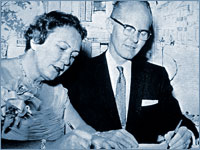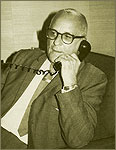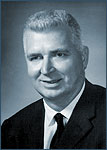The Merger


Interviews
Amalgamation of Osteopathic and Allopathic Physicians in CaliforniaThe COA/CMA MergerAfter 50 years of segregated - with occasional side-by-side - practice of allopathic and osteopathic medicine in California, the leaders of the state osteopathic association seemed willing to forego its separate and self-proclaimed unique contributions to the healing arts in order to be acknowledged and respected by allopathy. Even though osteopathy had obtained the legal recognition of a fully licensed medical profession, the facts that many D.O.s were barred from consulting with M.D. specialists in hospitals and from admitting their patients to hospitals with specialized care, led some members in the osteopathic leadership to suggest a merger with the state allopathic profession. They saw this as a way to improve access of practice affiliation which would ultimately lead to improved healthcare for patients. This potential solution to easing the professional tensions found increasing support when one of the pioneers of osteopathy in California unexpectedly died in 1938. Carle Phinney, D.O. died in office as president of COP&S. He was the last president of COP&S who was an osteopathic physician and supporter of the profession’s ideal to function “separate but equal”. In looking for a replacement in the office of the president, various options were debated both at the school, among the alumni and at the California Osteopathic Association. It was the function of the Board of Trustees, though, to elect the school’s president, and they recruited Ballentine Henley, JD from the cabinet of the President at USC as their new president in 1940. He was the first president of the school who was not an osteopathic physician. According to the recollections of Warren Bostick, M.D., President Henley provided strong links to the world of finance, industry, education and the professions in Los Angeles. His term in office was to extend for longer than any of his predecessors, from 1940 to 1964, and as Provost until 1968. Preparing for a merger with allopathy In 1941, Forest Grunigen, D.O. who was a member of the Board of Trustees of the COA, announced that he would run for presidency of the COA, with the objective to organize an official committee to effect a merger. Dr. Grunigen was elected president of the COA and served from 1943 to 1944. Also favoring the merger idea was John Cline, M.D. from the California Medical Association. He became President of the AMA in 1951. Dr. Cline had been a consultant during the COA-CMA merger talks in 1943. He was favorably inclined toward the osteopathic professional organization. Drs. Grunigen, Carroll and Cline continued to promote the idea of a merger at the national level, i.e. between the AMA and the AOA but the AMA viewed osteopathy as a “cult” that could not be accepted into the folds of the AMA. Another supporter of the merger proposal was Senator Teale of California. For years, he had significantly affected the M.D.-D.O. relationship in his state. Dr. Steedman recalls that “Senator Teale was instrumental in getting the L.A. County Osteopathic Hospital built [in 1956-59].” Yet, only a few years later Senator Teale supported the merger between California’s osteopathic and allopathic professions. Since sparse official records are available on his merger-related activities, the recollections by Jay Michael, M.S. in his interview transcript on this website make a great difference in our understanding of Senator Teale. On July 17, 1960 the AOA House of Delegates heard the presentation by COA and resolved that any state society entering negotiations with another profession concerning unification or merger would be subject to possible revocation of its charter by AOA. On November 13, 1960 the COA House of Delegates in a special session voted 66-40 to continue talks with CMA despite a plea by the AOA president and the earlier warning that continuation would jeopardize the COA’s standing. A week later the AOA Board of Trustees in a special session revoked the charter of COA. Russell M. Husted, D.O. and member of the Board of Trustees of the AOA since 1956 lost his membership status. California’s D.O.s were now on their own, without organizational support and status at the national level. Dr. Dorothy Marsh had long been playing a crucial role. Dr. Marsh was president of COA when the merger began and gave the decisive presentation at the AOA House of Delegates. As president of the COA, Dorothy Marsh, D.O. signed the merger agreement with Paul Foster, M.D., president of the CMA, acting as “CMA Council” on March 29,1961. The agreement was approved by the CMA House of Delegates on May 3, 1961 (by a vote of 296 for vs. 63 against), and by the COA House of Delegates (100 for vs. 10 against) on May 17, 1961. Dr. Marsh signed the merger agreement once again, this time with newly elected CMA President Warren Bostick, M.D. on May 17, 1961 after both CMA and COA House of Delegates approved the agreement. Further details about the merger can be found in Chapter 4 of the book “The Merger, M.D.s and D.O.s in California”, available through Xlibris, 2008. |